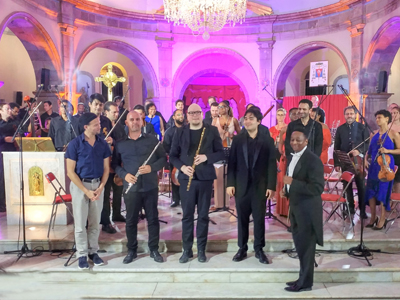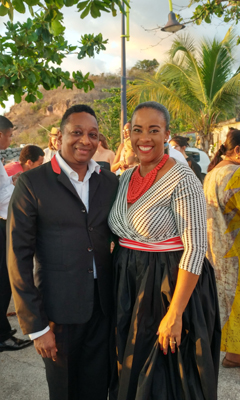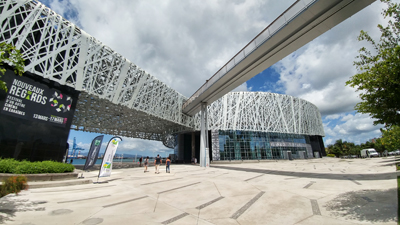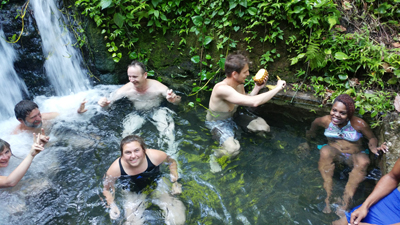Music: Sounds and Surf - The Saint-Georges International Music Festival,
Guadeloupe, French West Indies
By Mark Laiosa
arttimesjournal April 29, 2019
Lounging on a palm tree-fringed beach hearing a live string quartet in the balmy air is a fitting setting for native son, and composer, Chevalier Saint-Georges, born in Baillif, Basse-Terre in Guadeloupe on Christmas day 1745.
 Opening Night Concert at Notre Dame de Guadeloupe Church in Basse-terre |
The French West Indies are not usually associated with classical European music. The Festival International de Musique Saint-Georges is changing that perception. Marlon Daniel, artistic director and conductor is a visionary, leading the Saint-Georges Festival Orchestre, and the smaller Ensemble du Monde, in bringing world class performers to Guadeloupe for a five-day festival and involving local musicians. The second season concluded in mid-March 2019.
A Life Worthy of a Dumas Novel
Joseph Bologne was the son of a plantation owner George Bologne and his wife's slave-maid, Anne Nannon. The senior Bologne took Joseph and his mother to Paris, arranging a proper French gentleman's education. He became an excellent fencer and equestrian. Joseph's musical studies included violin, composing and conducting. His virtuosic violin and composing skills come to us in the extant music scores, mostly instrumental music - string quartets, violin concertos, sinfonia concertantes, and symphonies. Several operas are lost, fragments are infrequently performed and were featured in the festival, showing Saint-Georges' melodic style.
Bologne became a titled officer of the "King's Body Guard and a Chevalier," and adopted his father's suffix, Saint-Georges. During the French Revolution Bologne fought for the republic and was commissioned as a Colonel in the Legion de Saint-Georges, the first all-black regiment in Europe. One of his lieutenants was Thomas Dumas the father of novelist Alexandre Dumas.
Saint-Georges was the music director for the Duc D'Orleans and lived in the ducal mansion. Mozart was in Paris with his mother during 1778 when she died. Mozart moved into the mansion for a little more than two months and met Saint-Georges, 11 years his senior. Speculation abounds on Saint-Georges' influence on Mozart.
Concerts on this butterfly-shaped island, really two islands separated by a sea water channel, called the Salee river, are performed in hotels, outdoor stages, historic churches and the 500-seat concert hall in the L'artchipel.
Nightly concerts leave the day time to explore, climb a volcano, soak in a rain forest pool, or sample a variety of rums at the Bologne Distillery and taste the marvelous blends of Caribbean and French cuisines throughout Guadeloupe.
The prelude afternoon concert was given in Baillif, Basse-Terre on an outdoor stage. It featured Saint-Georges's string quartets and two of his flashy opera arias sung by soprano Coretta Jean-Alexis Moueza.
 Conductor Marlon Daniel and Soprano Coretta Jean-Alexis Moueza post afternoon prelude concert |
Well known works were performed and a few surprises, a rarely heard Jolivet flute concerto performed by Sami Junnonen, and the world premiere of a contemporary piece, Suite Caraibeenne Pour Orchestre by Jonathan Grimbert-Barre, is cinematic and evokes Guadeloupe's natural beauty.
Daytime explorations and nighttime concerts
One not to be missed daytime activity is a visit to the massive Memorial ACTe, the Caribbean Center for the Expressions and Memories of Trafficking and Slavery. It has two parts, a temporary art exhibition space and the Memorial that is within a black box representing the victims of the slave trade. The flecks of quartz embedded in the façade, reflect sunlight and represents the missing spirits. Orchid air root-like shafts of silvery metal come down over the box towards the earth, protecting the memory of those lost. There's a bridge with stainless steel rods, that's approximately 40 feet overhead and spans 900 feet with seascape and hillside views.
The Memorial has several galleries filled with slave chains, branding irons, miniature dioramas, and documents institutionalizing the enslavement of fellow humans. Video loops and audio prompts illustrate the history of African enslavement and moves to contemporary slavery. The impact on the most vulnerable, children and sex trade workers, that now includes the growth in human organ trafficking is given in numbers and images from countries around the world. Successful struggles for freedom are shown and reminds the visitor that changes can be made.
ACTe was nominated for the Council of Europe Museum Prize for 2017. Cameras and cell phones are not permitted in the museum, lockers are provided with a one Euro coin returnable deposit to store your gear. The wall text is in French and English, audio guides are available. ACTe is part of the UNESCO Slave Route Project.
 ACTe, Designed by a group of local and
international architects ACTe, Designed by a group of local and
international architects |
 Making new acquaintances in a tropical pool |
Guadeloupe, as a part of France, has its own National Park worth a visit with the active Soufrieres volcano at 4,800 feet, giving spectacular views when the clouds clear, or visit the waterfalls near the Corosol river and sit in the small pools set in the forest where locals and visitors enjoy the cascades.
To experience human interactions with plants, visit the Ecomusee Creole de la Guadeloupe in Sainte-Rose, with signage in French, English, and German. You can see, smell, and in some cases, taste the delights of the tropic's bounty and learn of the medicinal uses of plants. There is also a botanical garden in Deshaies with colorful parrots and pink flamingos.
While in Deshaies, fans of the PBS series Death in Paradise can visit a small museum of costumes and artifacts and walk to filming sites around the town used for the fictional Caribbean island of Saint-Marie.
Opera finale
The final concert of the festival was a homage to Leontyne Price at the historic St. Pierre and St. Paul Church in Pointe-a-Pitre and aired live on television. A local group, Choeur des Hommes de Baillif, created the somber atmosphere for Miserere, from Verdi's Il Trovatore.
Dramatic selections from Verdi and Bellini were sung by an ensemble of strong voices that recalled the honored diva's most important roles.
Sopranos Léïla Bredent and Janinah Burnett; mezzo-soprano J'Nai Bridges, Chauncey Packer, tenor; Darnell Ishmel, baritone; and Soloman Howard, bass entranced the audience that called for encore! And were obliged with Verdi's Brindisi, the drinking song from La Traviata, along with champagne flutes and lots of bubbly.
Maestro Daniel has grand plans for the next festival. More details can be found on the Saint-Georges Music Festival Website. http://saintgeorgesfestival.com/en/
Mark Laiosa writes about a wide range of cultural topics and is a radio
presenter in New York City.
